14
14.1 Introduction
LEARNING OBJECTIVES
- Understand the primary federal anti-discrimination laws.
- Learn the procedure for bringing and defending against discrimination complaints.
- Explore how businesses can protect themselves from discrimination claims.
The Civil Rights Movement of the 1960s resulted in several important federal laws that addressed discrimination. The first was the Equal Pay Act of 1963, which requires equal pay for equal work, regardless of the worker’s gender. Title VII of the Civil Rights Act of 1964 is probably the most well-known of the civil rights legislation. Title VII prohibits employment discrimination on the basis of race, color, religion, gender and national origin. Since the 1960s, more laws have been passed to refine what constitutes discriminatory practices and expand coverage to additional groups, such as people with disabilities.
Figure 14.1 Participants in the 1963 March on Washington
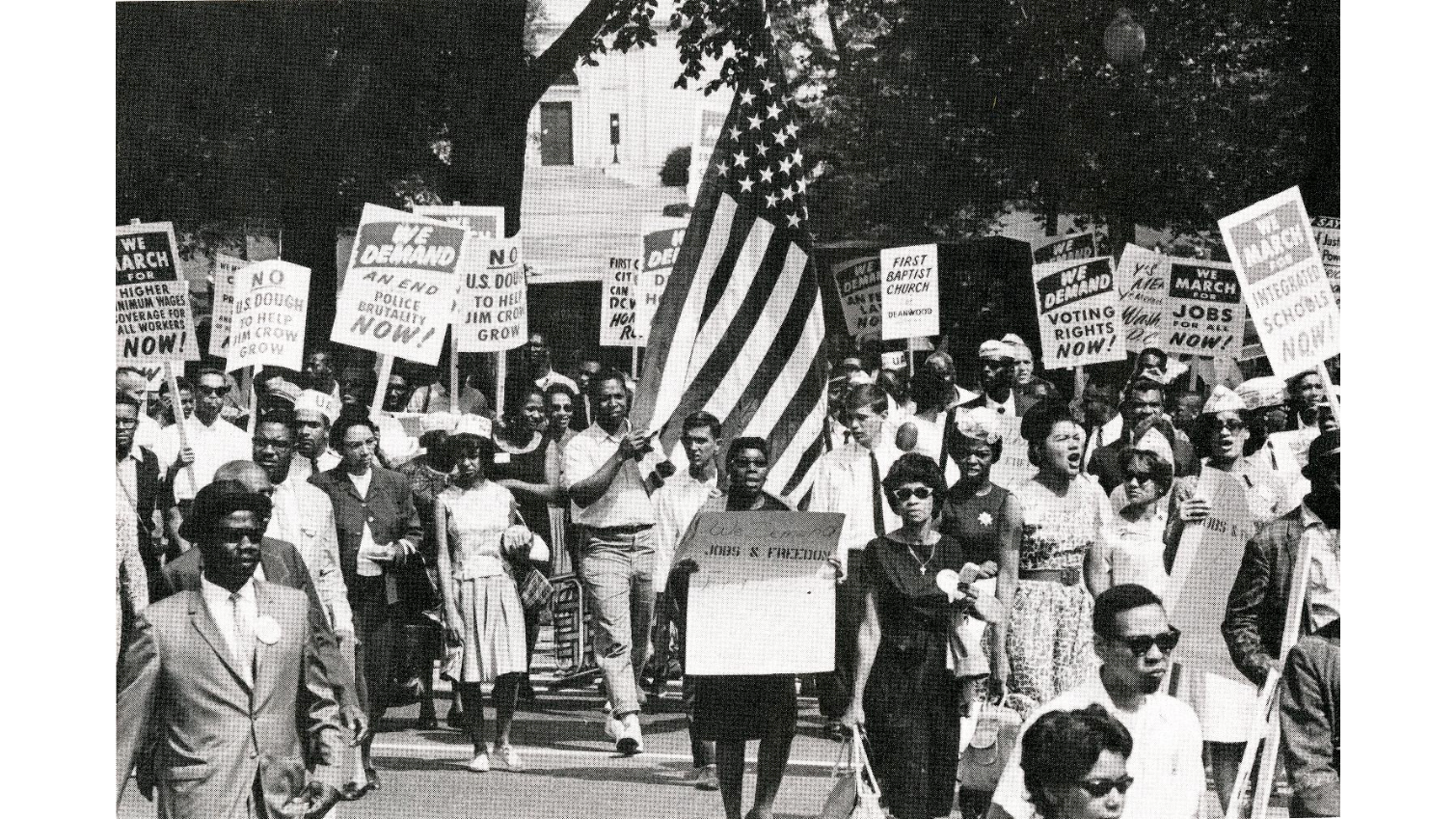
It is important for businesses to know and comply with these laws so they are not liable for discriminating against their employees, customers, and members of the public. State and local governments may pass laws that expand or provide protections to additional groups but they cannot reduce protections found in federal law.
| Type of Discrimination | Federal Anti-Discrimination Laws |
| Race | Title VII of the Civil Rights Act of 1964 |
| Color | Title VII of the Civil Rights Act of 1964 |
| Religion | Title VII of the Civil Rights Act of 1964 |
| National Origin | Title VII of the Civil Rights Act of 1964;
Immigration Reform and Control Act of 1986 |
| Gender | Equal Pay Act of 1963;
Title VII of the Civil Rights Act of 1964; Pregnancy Discrimination Act of 1978 |
| Age | Age Discrimination in Employment Act of 1967 |
| Disability | Americans with Disabilities Act of 1990;
Americans with Disabilities Amendments Act of 2008 |
| Genetic Information | Genetic Information Nondiscrimination Act of 2008 |
14.2 The Equal Pay Act of 1963
The Equal Pay Act of 1963 seeks to eliminate the wage gap between men and women. In 1963, women earned roughly fifty-nine cents for every dollar men earned. In 2019, that number increased to seventy-nine cents. The Equal Pay Act requires employers to provide equal pay for equal work, and it applies to all employers. All forms of compensation are covered by the Act, including benefits such as vacation and compensation such as salary and bonuses.
Figure 14.2 Median Weekly Earnings by Gender and Educational Level from US Department of Labor
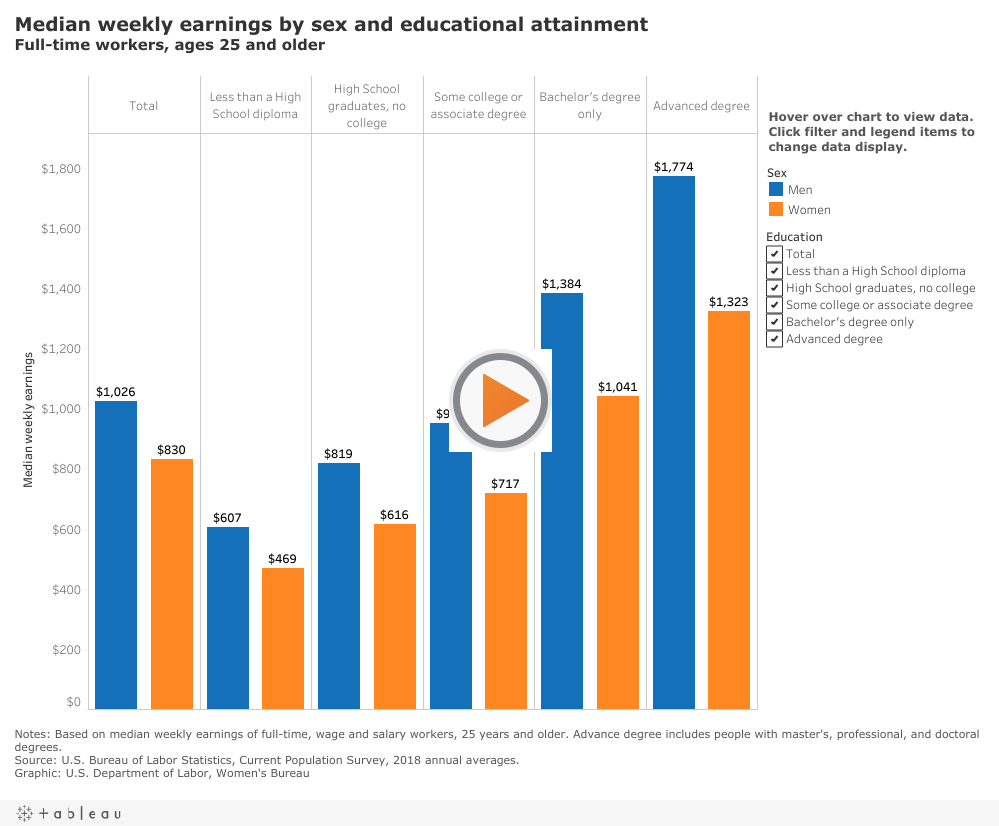
Victims do not need to file a complaint with the Equal Employment Opportunity Commission (EEOC) but may file an equal pay claim in federal court, as long as they do so within two years after learning of the inequality in pay or benefits. Victims typically also pursue Title VII claims at the same time they pursue Equal Pay Act claims.
The Equal Pay Act is difficult to enforce. Since demanding identical pay is virtually impossible due to differences in jobs and job performance, courts have essentially interpreted the law as requiring equal pay for substantially equal work. A common problem occurs when women voluntarily leave the workforce to raise children. This can result in a challenging comparison between a woman’s experience for pay purposes and her male counterparts, who may not have an interruption in their careers.
Figure 14.3 Participation Rates for Women Professionals from Equal Employment Opportunity Commission
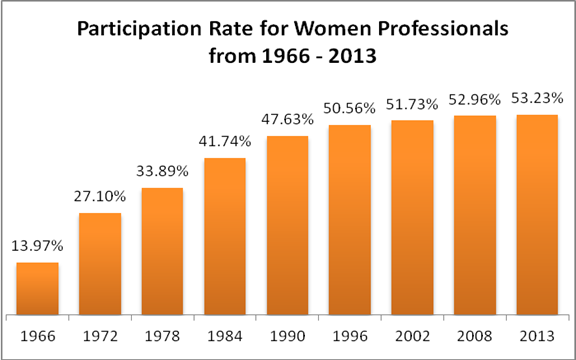
14.3 Title VII of the Civil Rights Act of 1964
The Civil Rights Act of 1964 has broad significance for all racial minorities, religious organizations, and women. The bill has several provisions, but the most important for businesses is known widely as “Title VII.” It applies to employers with more than fifteen employees. Its aim is to eliminate discrimination on the basis of:
- Race;
- Color;
- Religion;
- Gender; and
- National origin.
Discrimination on any of these bases is illegal. These acts may be a refusal to hire, a failure to fully compensate, a failure for opportunities for advancement, a demotion, a temporary layoff, a termination of employment, or any other term or condition of employment.
Figure 14.4 Employment Discrimination Claims Made to the Equal Employment Opportunity Commission
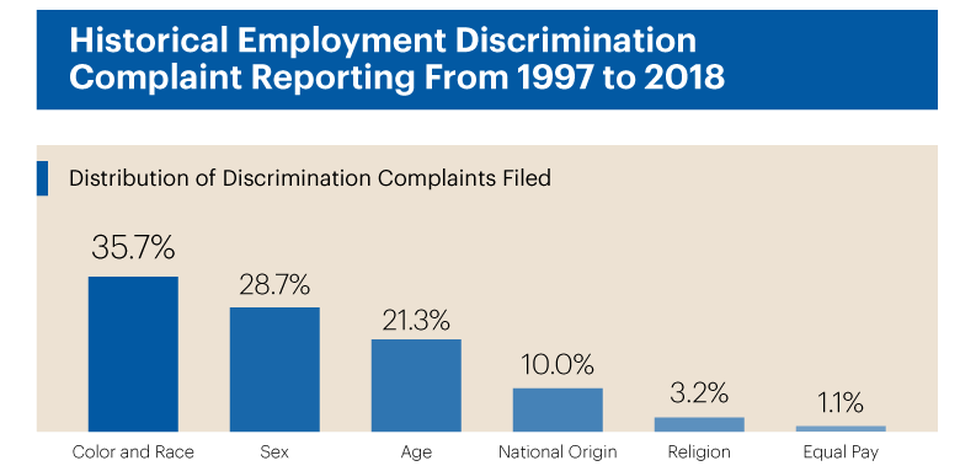
Race and Color
Race discrimination involves treating someone unfavorably because he or she is of a certain race or because of personal characteristics associated with race, such as hair texture, skin color, or certain facial features. Color discrimination involves treating someone unfavorably because of skin color or complexion.
Race and color discrimination also can involve treating someone unfavorably because the person is married to, or associated with, a person of a certain race or color. Race and color discrimination can occur within the same racial group.
Figure 14.5 Participation Rates for African Americans Professionals from Equal Employment Opportunity Commission
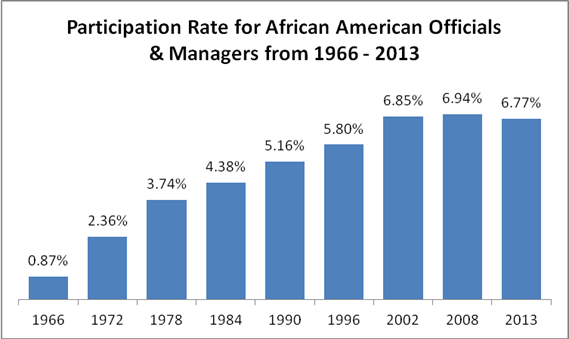
Religion
The prohibition against religious discrimination protects anyone who has sincerely held religious or moral beliefs. Therefore, Native American tribes are protected, as well as major religions such as Buddhism, Christianity, Hinduism, Islam, and Judaism. In general, employees cannot be required to participate in religious activities as a condition of employment, unless the place of employment is a church, synagogue, mosque, or temple.
Employers must reasonably accommodate an employee’s religious beliefs or practices as long as it does not cause an undue hardship on the employer’s operation of its business. Typically, this involves being flexible in schedule changes and leaves for sabbath observance or religious holidays. Issues of dress and appearance are often grounds for charges of religious discrimination. For example, if a Muslim woman wears a hijab, or traditional headscarf, then she should be permitted to do so unless it places an undue hardship on business operations.
Gender
The prohibition on gender discrimination means that employers cannot categorize certain jobs as single-sex only unless a bona fide occupational qualification (BFOQ) applies. Customer preferences or market realities are not the basis for BFOQ. However, an example of a legitimate BFOQ is hiring female security officers to monitor women’s changing areas for loss prevention in retail stores.
Gender discrimination also includes making stereotypical assumptions about women simply because they might be the primary caregiver to children at home. If there are two equally qualified job applicants, for example, and both have young children at home, it would be illegal to give preference to the male candidate over the female candidate. Once a female employee has children, it would be illegal to assume that she is less committed to her job, or would like to work fewer hours. It’s important to note that these protections extend to men as well. If an employer voluntarily provides time off to new mothers, for example, it must extend identical benefits to new fathers.
Figure 14.6 Pew Research Center Results Regarding Gender Discrimination at Work
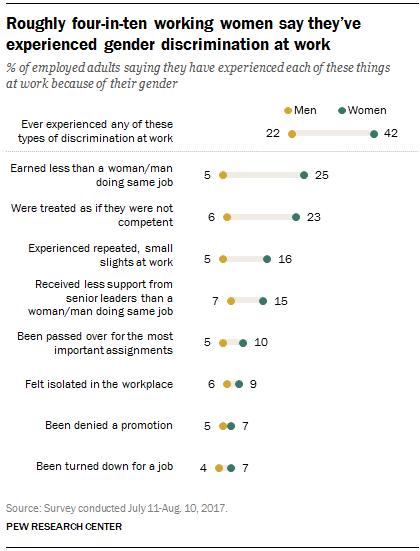
In 2019, unmarried childless women earned 95 percent of what men did, while married mothers earned 75 percent (averaging to 79 percent as discussed above). This discrepancy has led to an increase in family responsibility discrimination claims under Title VII. This includes claims that mothers are given less-appealing assignments than fathers based on misconceptions about being less qualified or lacking commitment to the job.
The Pregnancy Discrimination Act of 1978 amended Title VII to make it illegal to discriminate on the basis of pregnancy, childbirth, or related medical conditions. This means employers cannot refuse to hire a woman because she is pregnant or is considering becoming pregnant, or because of prejudices held by coworkers or customers about pregnant women. A female worker who becomes pregnant is entitled to work as long as she can perform her tasks, and her job must be held open for her while she is on maternity leave. Furthermore, pregnancy-related benefits cannot be limited only to married employees.
Gender discrimination can also take the form of workplace sexual harassment. Courts have generally recognized two forms of sexual harassment. The first, known as quid pro quo, involves asking for sexual favors in return for job opportunities or advancement. Courts reason that if a male worker asks a female worker for sex in return for favorable treatment, it is because that worker is female, and therefore a Title VII violation has occurred. If a supervisor fires a subordinate for breaking up with him or her, then quid pro quo harassment has taken place. The second is hostile work environment, which is discussed in more detail below.
National Origin
Discrimination on the basis of national origin involves treating workers unfavorably because of where they are from (specific nation or region) or ethnicity. It is illegal to discriminate against a worker because of his or her foreign accent unless it seriously interferes with work performance. Workplace “English-only” rules are also illegal unless they are required for the job being performed.
The protected class of national origin means that it is illegal to discriminate against noncitizens. Therefore, employers should not ask job applicants about their nation of origin. Instead, they are permitted to ask whether the applicant is authorized to work in the US. If they applicant answers “yes,” then the employer cannot ask for evidence of authorization until the applicant is hired and completes the Employment Eligibility Verification (I-9) Form.
Title VII creates only five protected classes. Other characteristics, such as obesity, attractiveness, and political affiliation, are not protected classes. Note too that Title VII does not prohibit all discrimination. Employers are free to consider factors such as experience, business acumen, personality, and even seniority, as long as those factors are related to the job in question. Title VII requires employers to treat employees equally, but not identically.
Prohibited Activities
There are four types of illegal activities under Title VII:
- Disparate Treatment;
- Disparate Impact;
- Hostile Work Environment; and
- Retaliation.
To prove a disparate treatment case, a plaintiff must show that he or she was treated differently because of his or her race, color, religion, gender or national origin. In other words, disparate treatment is intentional discrimination. Winning a disparate treatment case is hard because it is unusual for a defendant to say explicitly that his or her intention is discriminatory. Evidence of discriminatory intent is often inferred through someone’s conduct. For example, a hiring manager refuses to hire women because he does not want to deal with maternity leave requests would be evidence of disparate treatment.
Disparate impact, on the other hand, applies when a rule or policy is not discriminatory on its face but negatively impacts a protected group when it is applied. In other words, disparate impact is unintentional discrimination. Business policies that raise suspicions of disparate impact include educational qualifications, written tests, intelligence or aptitude tests, height and weight requirements, credit checks, and subjective procedures such as interviews. Businesses that have these sorts of policies need to be very careful that the policies are directly related to, and necessary for, the job function under consideration.
Figure 14.7 Disparate Impact Cartoon
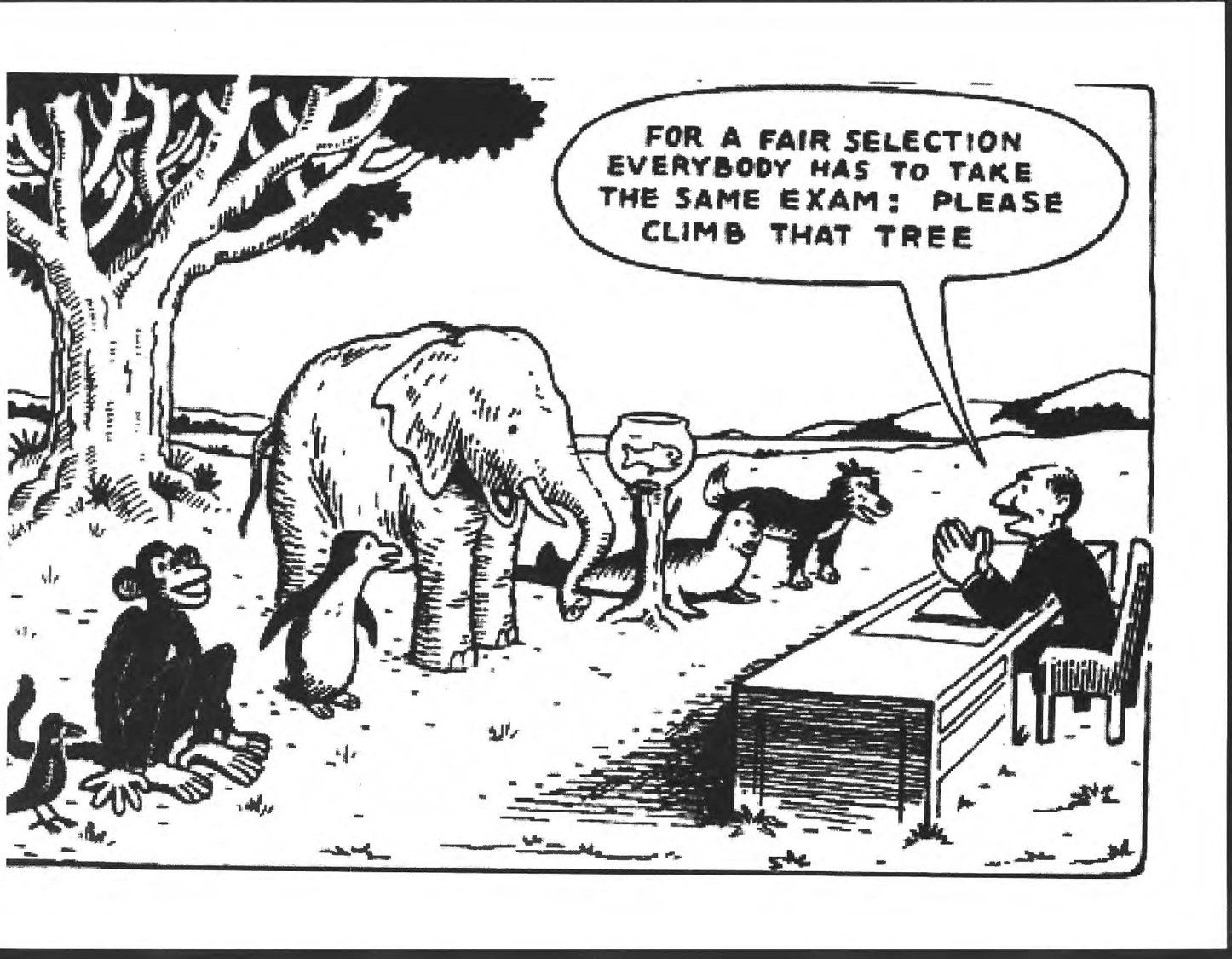
Proving a disparate impact case is not easy for victims of discrimination. It is not enough for the employee to use statistics alone to show a policy or practice has a disparate impact on the victim’s protected class. Victims must show that they were harmed from the discriminatory practice.
Employers also violate Title VII if they have a hostile work environment towards people in a protected category that affects their ability to work. These cases often involve allegations where a company or employees try to get a member of a protected group to quit through name calling, undesirable work assignments, slurs, and threats. Employers are liable for hostile work environment claims if the victim suffered a “tangible employment action” such as a demotion, undesirable reassignment, or termination of employment. Even if the victim did not suffer a tangible employment action, an employer may be liable unless it can prove (1) it used reasonable care to prevent and correct the inappropriate behavior, and (2) the victim unreasonably failed to take advantage of the company’s complaint procedures.
Hostile work environment claims often involve allegations of constructive discharge. Constructive discharge occurs when an employer makes the employee’s working conditions so intolerable that a reasonable employee would feel compelled to quit. Constructive discharge claims recognize that employees should not be forced to stay in situations that risk their physical, mental, and emotional safety.
Title VII also prohibits acts of retaliation against anyone who complains about, or participates in, any employment discrimination complaint. Employers need to be very careful about this provision, because while the employer may be innocent of the first charge of discrimination, taking any subsequent action after an employee has complained can be a separate charge of discrimination. Once an employee has made a complaint of discrimination, it is very important that the employer not alter any condition of his or her employment until the complaint has been resolved. Similarly, if a witness takes part in an investigation or hearing of another employee’s complaint, the witness could also bring charges of retaliation.
Bona Fide Occupational Qualification
The law does, however, allow discrimination on the basis of religion, gender, and national origin if a bona fide occupational qualification (BFOQ) reasonably necessary for normal business operations exists. For example, a Jewish synagogue may restrict hiring of rabbis to Jewish people only, and a Catholic church can restrict hiring priests to Catholic men only. Since BFOQ discrimination extends to national origin, a producer casting for a role that specifically calls for a Filipino actor can legally restrict hiring to Filipinos only.
Managers should be very careful in applying BFOQ discrimination. It is an exception that is very much based on individual cases and subject to strict interpretation. The BFOQ must be directly related to an essential job function to be “bona fide.” Customer preference is not a basis for BFOQ. For example, airlines cannot refuse to hire men even if surveys show customers prefer female flight attendants.
14.4 Enforcement of Title VII
Equal Employment Opportunity Commission
The Civil Rights Act of 1964 is a federal law, but it does not give victims of discrimination the immediate right to file a federal lawsuit. Instead, the Act created a federal agency, the Equal Employment Opportunity Commission (EEOC) to enforce civil rights in the workplace. The EEOC publishes guidelines to assist businesses in deciding what employment practices are lawful. The EEOC also investigates complaints filed by workers who believe they are victims of unlawful discrimination. If the EEOC believes that unlawful discrimination has taken place, the EEOC can file charges against the employer.
Employees must file a Title VII charge with the EEOC before going to court. If the EEOC investigates and decides not to pursue the case any further, the EEOC will issue a “right to sue” letter. With that letter, the employee can then file a case in federal court within 90 days of the date of the letter. Any EEOC complaint must be filed within 180 days of the alleged discriminatory act taking place. If employees wait beyond 180 days, their claims will be dismissed.
In 2009, the Lilly Ledbetter Fair Pay Act clarified that discriminatory pay decisions occur every time unequal compensation is paid and the statute of limitations begins again on the date of each unequal paycheck. Therefore, plaintiffs have 180 days from the time they receive a discriminatory paycheck to file a complaint with the EEOC.
The EEOC has the authority to award several remedies to victims of discrimination. These include the award of back pay for any lost wages, the issuance of an injunction to stop the employer from continuing any acts or policies of discrimination, ordering a terminated or demoted employee reinstated to his or her prior position, and the award of compensatory damages for out-of-pocket costs resulting from the discrimination as well as emotional harm. In cases of severe or reckless discrimination, punitive damages are also available.
EEOC Procedure
After receiving the charge, the EEOC will investigate the allegations. If there is sufficient proof of discrimination, the EEOC may (1) help the parties reach a settlement; (2) impose sanctions; or (3) prosecute the case in federal court. The EEOC’s investigative and enforcement powers are broad.
When filing a complaint, the plaintiff must show a prima facie case of discrimination. This means that “on first look,” the plaintiff has evidence that the defendant discriminated against him or her based on membership in a protected class. The plaintiff is not required to prove discrimination at this stage. Instead, the plaintiff must show only a presumption that discrimination occurred.
The defendant then files a response and may present evidence that its decision was based on a legitimate, non-discriminatory reason or business necessity. For example, an employee was fired for poor performance rather than membership in a protected class.
After the defendant presents its case, the plaintiff must show that the defendant’s reason is pretext. In other words, the reason the defendant gave was a “cover” for discrimination. In disparate impact cases, the plaintiff may show that less discriminatory rules would achieve the same result.
The case is investigated and decided by the EEOC hearing officer. The officer will issue either a finding on the charge or a notice of the right to sue, after which an employee has 180 days to file a discrimination complaint in federal court.
Figure 14.8 Burden of Proof in Equal Employment Opportunity Commission Charges
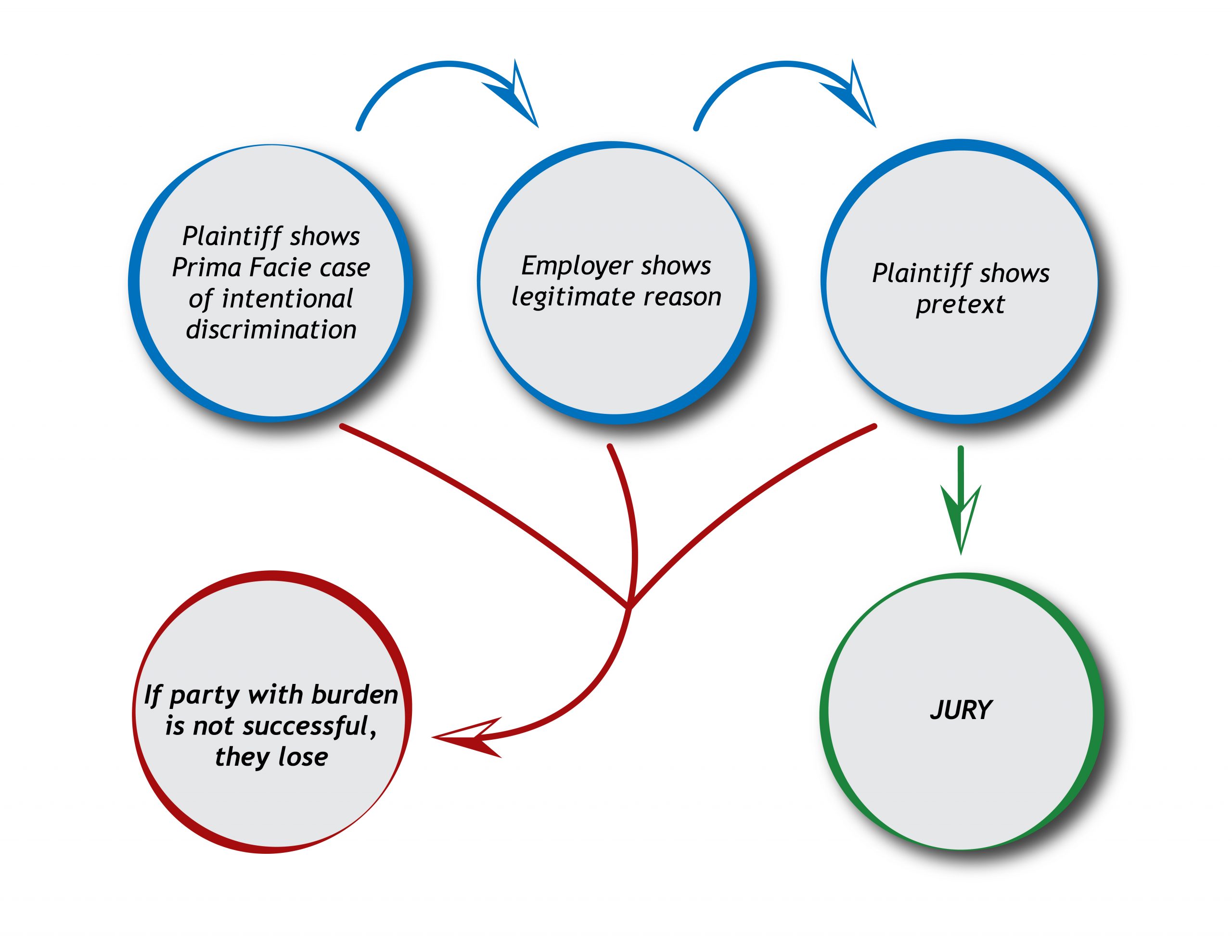
Affirmative Action
To correct past mistakes in treatment of women and minorities, many businesses go beyond being equal opportunity employers by adopting affirmative action programs. Businesses are not legally required to undertake affirmative action programs, but many do. Businesses may voluntarily undertake affirmative action programs, as long as those programs are meant to correct an imbalance in the workforce, are temporary, and do not unnecessarily infringe on the rights of non-beneficiaries.
Affirmative action plans can be tricky to administer because Caucasian Americans can also be the victims of race discrimination, which is often called reverse discrimination. The provisions of Title VII are meant to protect all individuals from race discrimination.
The EEOC will take into consideration if a defendant’s actions are part of an affirmative action program. However, businesses may still be liable for discrimination even if they adopt an affirmative action program. Therefore, businesses should be careful that they are not adopting a program that results in disparate impact claims from other protected groups.
14.5 The Age Discrimination in Employment Act of 1967
The Age Discrimination in Employment Act of 1967 (ADEA) makes it illegal to discriminate against workers over the age of forty. It does not protect younger workers so an employer may favor an older worker over a younger worker. The ADEA applies to any employer with over twenty workers, including state governments. The ADEA prohibits employers from treating any covered person unfavorably in any term or condition of employment, including the hiring decision. It is illegal, for example, to hire an inexperienced twenty-five-year-old for a job when a fifty-year-old is better qualified and willing to work under the same conditions. Mandatory retirement age is illegal under the ADEA, except for very high-level executives over the age of sixty-five who are entitled to a pension.
Employers may discriminate against older workers if there is a bona fide occupational qualification such as a production company casting for a young actor to play a young character, or airlines setting a mandatory retirement age for pilots.
Of course, older workers can still be dismissed for good cause, such as poor job performance or employee misconduct. Companies may also administer a layoff plan or early retirement plan that is evenly applied across all workers, and can offer early retirement incentives to induce workers to retire.
In 2005, the Supreme Court held that the disparate impact theory can apply to age discrimination cases. For example, an employer cannot require office workers to undertake strenuous physical tests if those tests are not related to the job being performed and would have a disparate impact on older workers.
14.6 The Americans with Disabilities Act of 1990
The Americans with Disabilities Act of 1990 (ADA) and the Americans with Disabilities Amendments Act of 2008 (ADAA) expand the promise of equal opportunity in the workplace to cover persons with disabilities. It is illegal for employers with fifteen or more employees to discriminate against “qualified individuals with disabilities.”
The ADA only applies to the qualified disabled. To be qualified, the individual must meet the legitimate skill, experience, education, or other requirements for the position he or she is seeking and be able to perform the “essential functions” of the job without reasonable accommodation. In other words, the first step an employer must take is to define what the essential functions of the job are, and then see if a disabled individual who has applied for the job meets the requirements for the job and can perform those essential functions. Obviously, someone who is legally blind will not be permitted to be a bus driver or airline pilot under this test.
On the other hand, the “essential functions” test means that employers must be very careful in denying employment to someone who is disabled. If the reason for denying employment is the disabled person’s inability to perform some incidental task (rather than an essential function), then that is illegal discrimination. The ADA also permits employers to exclude any disabled individual who poses a direct threat to the health or safety to the individual or of others, if the risk of substantial harm cannot be reduced below the level of “direct threat” through reasonable accommodation.
The ADA makes it illegal for an employer to require a job applicant take a medical exam before an employment offer is made. However, after a job offer has been made, applicants can be asked to take medical and drug exams. Tests for illegal use of drugs, any time during employment, are permitted under the ADA.
One of the hardest challenges is defining who is disabled. The ADA states that an individual is disabled if he or she has a “physical or mental impairment that substantially limits one or more major life activities,” has a record of such impairment, or is regarded as having such an impairment. Major life activities include seeing, hearing, speaking, walking, running, breathing, learning, and caring for oneself.
Consider a person being actively treated for cancer. During the treatment, many major life activities may be substantially limited, so the person is disabled. However, if a major life activity is not limited but the person loses his or her hair as a result of chemotherapy, he or she may be “regarded” as having an impairment, which makes him or her disabled under the ADA. An employer who purposefully refuses to hire a qualified job applicant with no hair because the employer believes the applicant has cancer (regardless of whether the cancer is active or in remission) is therefore violating the ADA. Finally, if the cancer patient recovers fully and has no physical sign of cancer, that patient is still considered protected by the ADA because he has a “record” of a qualifying disability.
Employers must provide reasonable accommodations to any disabled worker who asks for it. A reasonable accommodation is any change or adjustment to the work environment that would allow the disabled worker to perform the essential functions of the job or to allow the disabled worker to enjoy the benefits and privileges of employment equal to employees without disabilities. Reasonable accommodation might include allowing the worker to work part-time; reassigning the worker to a vacant position; purchasing special equipment or software; providing e-readers; or making an exception to an employment policy. Employers do not have to undertake reasonable accommodation if doing so would cause them undue hardship, meaning it would require significant difficulty or expense, or significantly alter the nature or operation of the business. Among factors to be considered in whether an accommodation would pose an undue hardship are the cost of the accommodation as well as the employer’s size and financial resources.
Figure 14.9 Americans with Disability Act Decision Tree
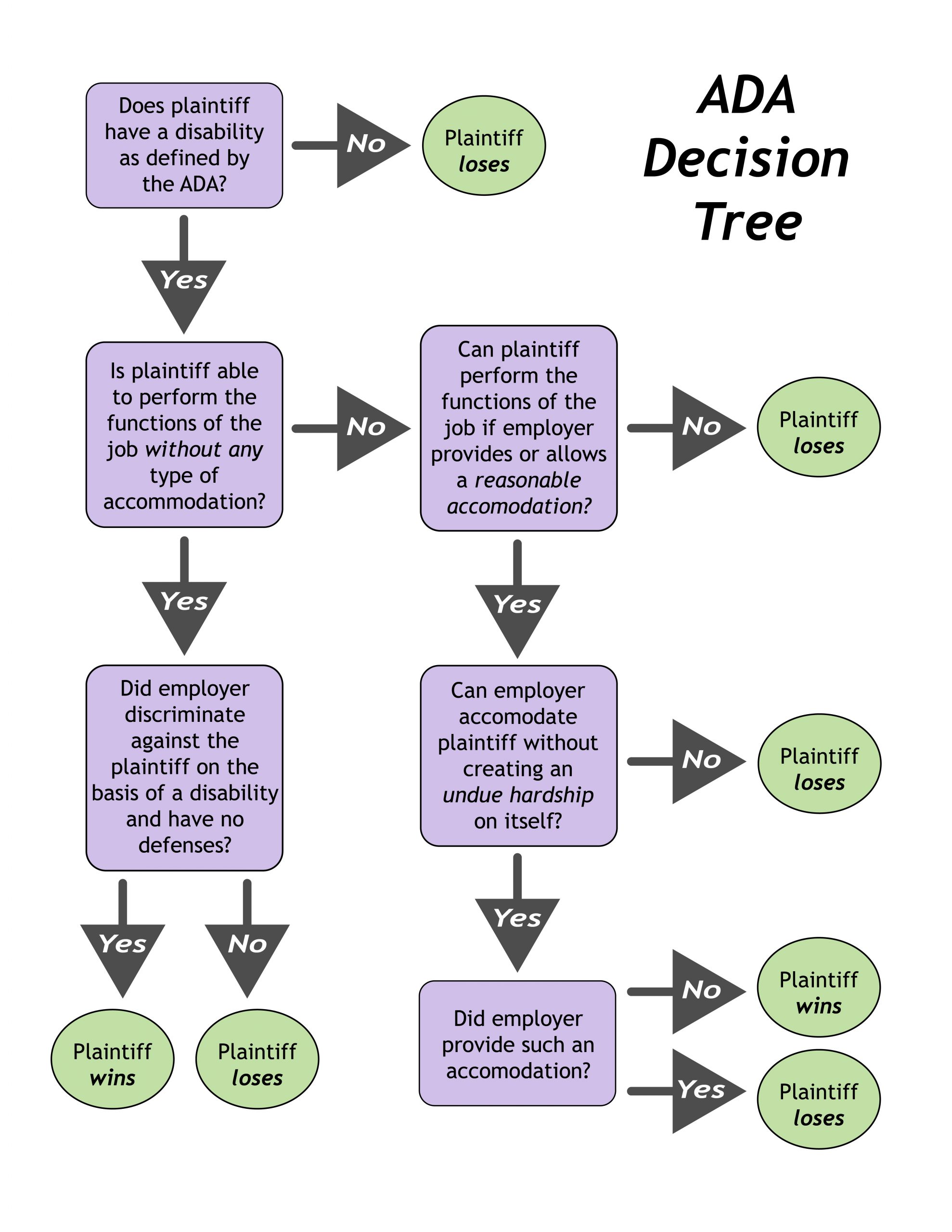
14.7 Genetic Information Nondiscrimination Act of 2008
In 2008, Congress passed the Genetic Information Nondiscrimination Act (GINA) to protect individuals from adverse decisions based on their genetics. Under GINA, employers may not require genetic testing, or use information about genetics (including family medical history) as a factor in hiring, promoting, demoting, or firing employees. This includes if an employee is a caretaker for someone with a genetic disorder. Health insurers cannot use genetic information when making coverage and premium decisions. Finally, an employer wellness program cannot require participants to answer questions about their family medical history.
14.8 Concluding Thoughts
Anti-discrimination laws are important for businesses to understand and follow. State and local laws may expand protections and identify more protected classes. Therefore, it is important for businesses to research all levels of anti-discrimination laws that apply to them to ensure they are not liable for discrimination against their employees, customers, and members of the public.
The 1964 Civil Rights Act is an important law that affects most employers in the United States. Originally created to ensure the integration of African Americans into mainstream society, the law prohibits discrimination on the basis of race, color, religion, gender, and national origin. Some forms of discrimination on the basis of religion, gender, or national origin are permitted if a bona fide occupational qualification exists. The Equal Employment Opportunity Commission (EEOC) investigates charges of illegal workplace discrimination. These charges must be filed by workers within 180 days of the alleged discriminatory act occuring.
The EEOC’s investigation and enforcement powers are broad. Both parties have an opportunity to present evidence and argue their case to the EEOC. Filing a charge with the EEOC is required before filing a lawsuit alleging violations of Title VII in federal court.
The Americans with Disabilities Act prohibits employment discrimination against the qualified disabled and prohibits pre-employment medical testing. To be considered disabled, an individual must demonstrate a mental or physical impairment that substantially limits a major life activity. Disabled persons are entitled to reasonable accommodation in the workplace, as long as reasonable accommodation does not place any undue hardship on the employer.
